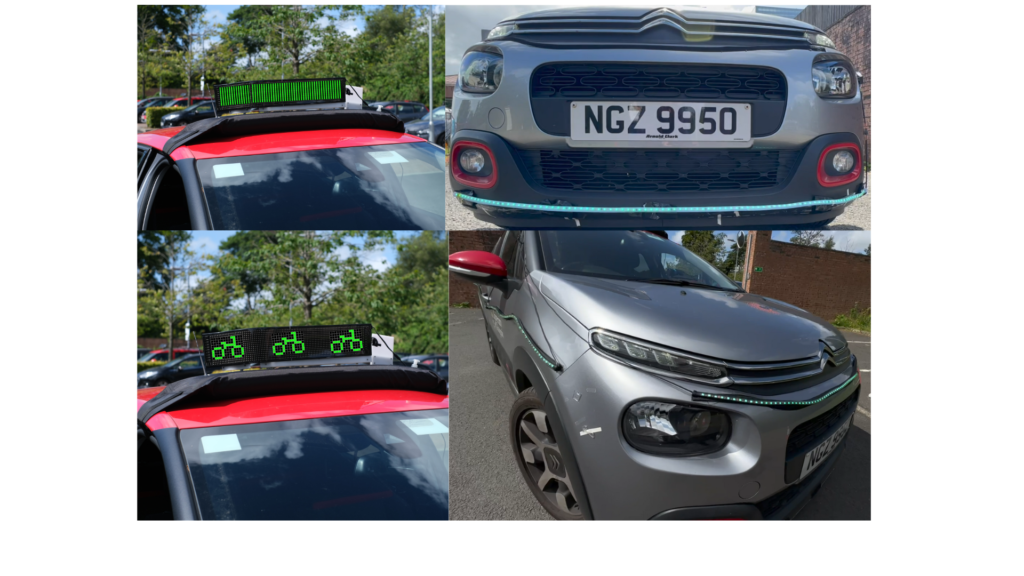On-board displays could be mounted on self-driving cars of the future to help reduce the road risks to cyclists, according to Glasgow researchers.
Mounted visual displays could be used to communicate a driverless vehicle’s next move – helping other road users such as cyclists anticipate their direction of travel.
University of Glasgow researchers found that coloured lights positioned on an automated car , could be the key to quickly and reliably signalling self-driving cars’ intentions to bike riders.
A new study suggests that a ring of pulsing coloured lights displayed on all sides of self-driving cars could be the most effective way for cyclists to determine where vehicles will move next.
The finding builds on several years of research by the team, which brings together human-computer interaction specialists and psychologists. They initially conducted a study to better understand the complex verbal and non-verbal communication between cyclists and human drivers, which helps determine who has the right of way in traffic and at junctions to prevent accidents.
Then, they worked with bike riders to design several prototype external human-machine interfaces (eHMIs) which could be added to the exteriors of autonomous vehicles to replace the complex language of human road users.
In the new study, the team took three of those prototype designs and tested their effectiveness by asking cyclists to interact with cars equipped with eHMIs, first in a virtual reality environment and then in the real world.
In the virtual environment, 20 volunteers cycled on stationary bikes while wearing VR headsets which showed them interactive videogame-like digital versions of city streets. While riding around the city in a series of different traffic situations, they encountered a simulation of a self-driving Citroen C3 hatchback equipped with one of the three prototype eHMIs.
One design used a digital screen on top of the car to flash emojis to bike riders, with a happy face to communicate yielding and a grumpy face to communicate the opposite. A second design projected colours onto the road around the car, with green to show the car would yield and red to confirm it would not. Finally, a ring of LEDs around the car’s exterior showed lights that bunched up to signal braking and spread apart to show acceleration.
The volunteers reported that they strongly preferred the simple red and green signals over the more complex emojis or light animations, which they felt took more time and effort to understand.
Ammar Al-Taie, of the University of Glasgow’s School of Computing Science, is the paper’s corresponding author. He said: “The VR portion of the study helped us to effectively test cyclists’ reactions to the three prototypes in an entirely safe and controlled environment.
“The results clearly showed that cyclists prefer visual signals which can be understood at a glance – they felt that the emojis were too complicated to ‘read’ without taking their eyes off the road for longer than was comfortable”.
“Once we had that feedback, we incorporated the recommendations into improved versions of the three interfaces and set out to test them in the real world.”
In the study’s second phase, the improved designs for LED strips, rooftop displays and projectors were added to the exterior of a real Citroen hatchback.
On a disused piece of road on the University’s Garscube campus, a hidden human driver piloted the car through simulated traffic situations while 20 volunteers biked alongside, watching the eHMIs for signals about the car’s intentions. The car’s driver wore a costume designed to look like a car seat to heighten the cyclists’ impression that they were interacting with a real self-driving car.
After each session of cycling, the cyclists gave their feedback on how effective they felt the eHMI was before moving on to another simulated traffic situation.
In this portion of the study, LED lights ringing the car edged out simple red/green signals as being most helpful for awkward lane merges and intersections. Adding pulses to the lights helped reinforce the meaning of the car’s intentions too.
In both stages of the study, having any interface was far better than no display for cyclist confidence and safety. When left to guess vehicle intent from driving behaviour alone, bikers slowed down, checked more over their shoulders, and reported feeling stressed.
